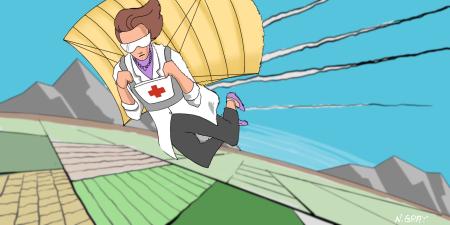Abstract
This case of cleft lip and palate repair by a surgical mission team is common. Low-risk, single-procedure surgical interventions requiring minimal follow-up with substantial quality of life improvement are well suited for this type of mission. However, cleft repair can also be quite complex and require multiple surgeries and other care over time, postoperative surveillance, and speech therapy. These benefits and burdens prompt us to investigate, from clinical and ethical perspectives, whether and when some surgical care is better than none. We argue that, when performing surgical interventions in low- and middle-income countries, mission teams should consider a systems-based approach that emphasizes collaboration, context, and sustainability.
Case
JJ was born with a cleft lip and palate. As a result, he has developed problems with oral competence, feeding, speech, and social acceptance—due to his appearance. He is 4 years old and lives in a rural community in Central Africa. JJ’s family heard that a group of surgeons from a university in the United States were coming to a nearby town to offer free cleft lip and palate repairs. JJ and his family and siblings traveled an hour to seek care, and JJ’s family waited all day to finally see the surgeon and resident physicians who repaired JJ’s cleft.
The resident physicians working on cases like JJ’s typically performed several surgeries a day while on location since they feel pressure to do as many as they can; they know that many of the children getting surgery will probably have significantly higher quality of life than those who do not.1 They also know, however, that patients like JJ will not have access to the same follow-up care as their patients in the United States, who would be followed by a multidisciplinary team of primary care clinicians, audiologists, otolaryngologists, orthodontists, and speech pathologists for the first 2 decades of life until the end of treatment.2 In addition, they know that many of their patients will be returning to homes with contaminated water and will face higher risk of postsurgical infection. Despite these worries, the resident physicians believe that the potential benefits to the children outweigh the potential risks.
After a few days, JJ and his family traveled home. JJ’s surgical sites appeared to be healing well, and the clinic sent the family home with dressings, antibiotics, and care instructions. After JJ’s wounds healed over the course of the year, his family noticed that his speech patterns did not seem to be improving and that he continued to have difficulty forming proper sounds and being understood. The visiting surgeons’ discharge recommendations included follow-up care with a speech pathologist, but JJ’s family was unable to access these services, which could only be found hours from their home. The surgeons also suggested that JJ consider a scar revision surgery after his face had developed more completely—at about age 18—but even if JJ’s parents could get him to a city where these services could be accessed, they are unable to afford additional care.
Commentary
Ethical dilemmas occur when stakeholders must choose between mutually exclusive options that each have associated risks and benefits. In this case, the options for the surgical mission team are not to provide cleft lip and palate repair for patients who will be unable to obtain full (ideal) postoperative care or to proceed with the initial surgical treatment after informed consent and give recommendations for future care, knowing that JJ might develop complications leading to morbidity. To address this ethical dilemma, we apply a framework based on the work of one of the authors (A.E.W.),3,4 which involves identifying stakeholders, establishing medical facts, eliciting the goals and values of the various stakeholders, and identifying benchmark norms in the context of the limitations that are inevitably present, particularly in resource-constrained settings.
Analytical Framework
Stakeholders. In this case, there are a number of stakeholders. The primary stakeholders are JJ and his family and the team of high-income country residents and surgeons. JJ’s life is directly affected by surgical repair of his cleft, and his family will be financially responsible for nonmedical direct costs and any future care. The visiting team invests time and effort to receive personal gain from the experience of providing surgical care to JJ. The local health care practitioners and the community as a whole are also important stakeholders when considering this case. Members of the local medical community presumably have limited surgical specialty education but will ultimately be responsible for provision of postoperative care. Moreover, the visiting team may utilize significant hospital resources during its visit by monopolizing operating room time, equipment, beds, and staff and by disrupting the hospital’s normal daily function. Finally, the community as a whole, which is involved in welcoming such visiting teams, the donor organization—if there is one—and the home institution of the visiting team are stakeholders in this case.
Medical facts. Cleft lip repair is a one-time, low-risk surgical procedure and lends itself well to surgical missions.5 Cleft lip and palate is more complex, as the lip is generally repaired first and the palate at a slightly older age.6 Early cleft repair before speech acquisition is preferred; approximately 20% of patients who undergo cleft palate repair require speech and language therapy.8 Although cleft lip and palate are generally not life-threatening conditions, they do have a real impact on affected children’s speech, feeding, and self-esteem and on the social interactions and lifestyle of both affected children and their families.1,7
Goals and values. It is critical for outside surgical teams to understand the patient’s and family’s perception of the disease and its possible effects in order to avoid misunderstandings attributable to cultural and language barriers.9 In order to better understand the family’s situation, the goals, values, and priorities of all involved must be defined and points of alignment and divergence identified. In this case, the shared goal of all stakeholders is improved quality of life for JJ and his family. However, the surgical team has additional goals that can conflict with this shared goal. One such goal is meeting donor expectations for the number of cases to be performed. Relatedly, residents want to see and perform as many difficult cases as possible for their educational benefit and personal sense of reward. If there is pressure to produce volume rather than best outcomes, it may lead to suboptimal long-term results for JJ. Similarly, the community may have other goals that conflict with the shared goal of improving JJ’s and his family’s quality of life. The community might prioritize providing other types of services for its members and might prefer to invest outside resources in other areas if given the chance. However, the allure of a wealthy foreign team also offers prestige and the opportunity to train local health care workers in highly specialized skills. Ideally, the goals and values of the local medical team would have been elicited prior to the visiting team’s arrival.
Norms for Ensuring Best Outcomes
Ethical norms for medical mission work can serve as benchmarks to help guide determination of whether a particular intervention meets ethical standards. These norms include adequate preparedness, continuity of care, competence, collaboration, sustainability, and outcomes monitoring.4
Preparedness. Preparation includes the team knowing the community in which it will be working and the resources available there. What are common cultural ideas and beliefs about cleft lip and palate, and what normally happens to patients with these conditions? What are the options for postoperative care in the local health care system, and how do patients access them? If the team has sufficient understanding of the conditions in which it will be working, team members can prepare for the challenges they are likely to face, such as limited operating room capacity, different instruments and materials, and different conceptions of disease. If any of the identified barriers are likely to be insurmountable, then teams should consider going somewhere else or working with local hosts to make conditions favorable to the mission prior to arrival.
Continuity of care. Building on preparedness, continuity of care is an expectation in high-income countries that a surgeon will be responsible for providing follow-up care or referring to someone who can follow-up with the patient as needed. In contrast, short-term teams depend on local health care workers to provide much of the postoperative care and long-term surveillance.3 Contextually relevant plans are thus needed for future follow-up and management.
Competence. Competence is particularly important when surgical trainees will be operating in a country whose regulations on health care practitioners may be less stringent than in the trainees’ home country. Trainees must have adequate supervision from the senior surgeons on the team and communicate their level of training and experience to patients, families, and local clinicians. Although cases that they see abroad might pose interesting and novel challenges, clinicians at all levels of training and experience should not routinely work outside their scope of practice. Patients are likely unaware of licensure regulations or the credentials of visiting team members and therefore cannot reasonably be expected to refuse care that might compromise their safety.
Collaboration. Collaboration with local clinicians ought to be a primary focus of specialized teams like the one in this case. The team must work to build trust with the local clinicians and community and recognize that it is working within an existing system so as not to undermine local physicians or erode local facilities such that they cannot continue to provide routine and essential surgical care. Additionally, the team should select patients based on recommendations from local clinicians, who likely have insight into patients’ situations that the outside team lacks.
Sustainability. In a related fashion, investment in sustainable interventions requires building local capacity to treat patients so that ultimately visiting teams will no longer be needed. The team would do greater long-term good if it spent a portion of its time training local physicians to assess and care for patients with cleft lip and palate with the aim of eventually replacing medical mission teams with local experts. While it is not realistic to train local surgeons to perform cleft repairs in such a short time, repeated visits or sponsoring select trainees to undergo further training are ways of investing in a sustainable health system. Perhaps the team could also solicit funding to bring a speech therapist to train someone locally to provide speech therapy.
Monitoring outcomes. Finally, the team ought to consider how to track the outcomes of the surgical cases it performs in order to assess its long-term impact. In the event long-term outcomes are less than desirable, the team could either stop providing care or find ways to ameliorate the outcomes, thereby avoiding a waste of resources. In the event that local capacity is inadequate to accomplish the goal of tracking outcomes, the visiting team could provide a system for doing so and train local health care workers to keep records and follow-up with patients postdischarge. The team’s broader resource investment would help ensure the best quality care and outcomes for patients it seeks to help.
Optimal Care for Context
This case demonstrates some of the many limitations present in resource-constrained settings. Time is a limiting factor for surgeons who do short-term missions, as they will, by definition, leave. Many cannot spend longer in a country building infrastructure or training local health care practitioners. In this case, the visiting team has a specialized treatment to offer that is not otherwise available to the community and has the potential to enhance JJ’s quality of life and ability to succeed. However, a one-time service is inadequate to fully treat his cleft lip and palate.
The optimal intervention, though still not perfect in the grand scheme of health equity, would be for this team to invest both in the cleft repair now and in health system strengthening through training local physicians and ancillary staff to provide surgical repair and postoperative therapy after the team leaves. In this way, some patients might receive less than the ideal standard of care in the short-term, but the investment of time and resources would provide benefit in the future by building a health system capable of eventually providing the full spectrum of cleft care.
References
- Naros A, Brocks A, Kluba S, Reinert S, Krimmel M. Health-related quality of life in cleft lip and/or palate patients—a cross-sectional study from preschool age until adolescence. J Craniomaxillofac Surg. 2018;46(10):1758-1763.
-
Shkoukani MA, Chen M, Vong A. Cleft lip—a comprehensive review. Front Pediatr. 2013;1:53.
-
Wall AE. Ethics for International Medicine: A Practical Guide for Aid Workers in Developing Countries. Hanover, NH: Dartmouth College Press; 2012.
- Wall AE. Benchmarks for international surgery. Arch Surg. 2012;147(9):796-797.
- Park YW. Successful surgical missions for cleft. J Korean Assoc Oral Maxillofac Surg. 2018;44(6):249-250.
- Farronato G, Kairyte L, Giannini L, Galbiati G, Maspero C. How various surgical protocols of the unilateral cleft lip and palate influence the facial growth and possible orthodontic problems? Which is the best timing of lip, palate and alveolus repair? Literature review. Stomatologija. 2014;16(2):53-60.
- Aslan BI, Gülşen A, Tirank ŞB, et al. Family functions and life quality of parents of children with cleft lip and palate. J Craniofac Surg. 2018;29(6):1614-1618.
-
Witt PD. Plastic surgery for cleft palate. Medscape. https://emedicine.medscape.com/article/1280866-overview. Updated May 20, 2019. Accessed June 9, 2019.
-
Kleinman A, Benson P. Anthropology in the clinic: the problem of cultural competency and how to fix it. PLoS Med. 2006;3(10):e294.



